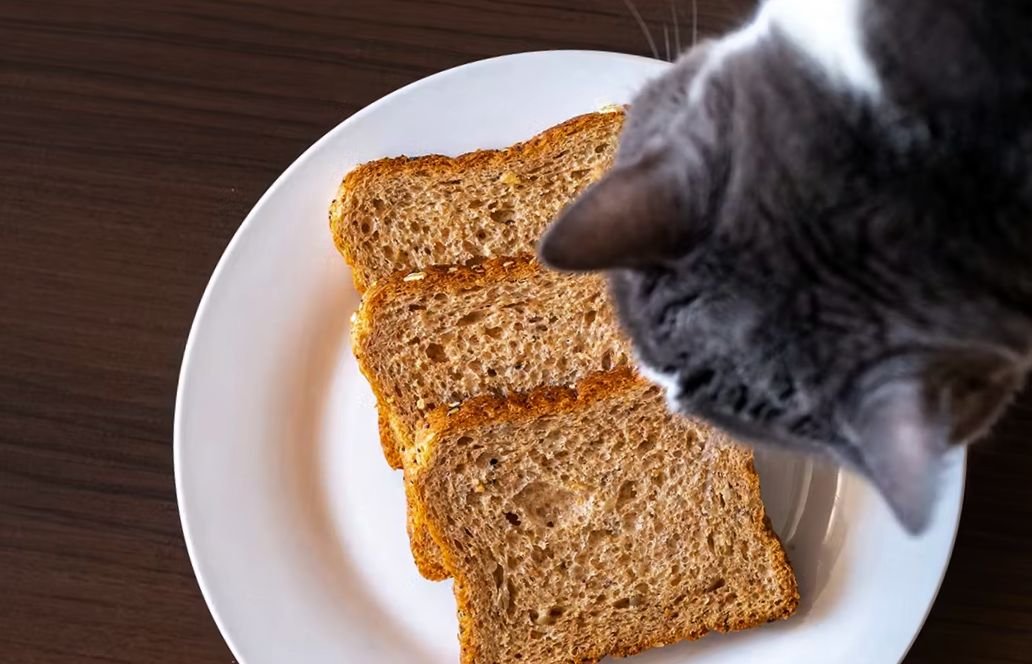While cats are known for their discerning tastes, many owners wonder if sharing a slice of brown bread with their feline friend is a harmless treat or a potential health hazard. Brown bread, a common food in many homes, might seem harmless for cats.
As a responsible cat owner, it’s essential to understand what foods are safe for your feline friend. One common question is, can cats eat brown bread? Read on to learn if can cats eat brown bread.
Nutritional Benefits of Brown Bread
While brown bread is not a necessary component of a cat’s diet, it can provide some nutritional benefits if fed in moderation as an occasional treat.
Brown bread contains fiber, which can support healthy digestion in cats. Additionally, it is made from whole grains, providing essential vitamins, minerals, and antioxidants. It also contains some protein, which is important for maintaining muscle mass and overall health.
However, it’s important to remember that cats have specific nutritional requirements, and brown bread should not replace their regular cat food. Always choose plain, unflavored brown bread and consult with your veterinarian before changing your cat’s diet.
Can Cats Eat Brown Bread?
It is the most frequently asked question that can cats eaYes, cats can eat small amounts of brown bread occasionally, but it should not be a regular component of a cat’s diet. Brown bread has some nutritional benefits for cats, such as fiber, protein, and B vitamins. However, it lacks essential nutrients like taurine and vitamins that cats require.
Is Brown Bread Good for Cats?
No, brown bread is not good for cats. Like all types of bread, it is empty calories for cats, providing no nutritional value. It can be a nutritious treat for cats in moderation, but it is not a substitute for their regular cat food.
While it provides some benefits, including fiber, protein, B vitamins, and minerals, it lacks essential nutrients like taurine, vitamin A, and arachidonic acid that are crucial for feline health.
Additionally, bread is high in carbohydrates, which can lead to weight gain in cats. Therefore it’s important to prioritize a balanced and complete cat food.
How to Safely Feed Brown Bread to Your Cat
Thinking of sharing a slice of brown bread with your feline friend? While bread can be a tasty treat for cats, it’s important to do so safely to avoid any potential health risks. By following a few simple guidelines, you can enjoy sharing brown bread with your cat while keeping their health and well-being top priority.
Check Ingredients
Ensure the bread doesn’t contain harmful additives like raisins, onions, garlic, or excessive salt.
Small Quantities
Offer only a small piece to avoid digestive issues.
Choose Plain, Unflavored bread
Avoid bread with added ingredients like onions, garlic, and chocolate, which can be toxic to cats.
Monitor
Watch your cat for any signs of digestive discomfort or allergic reactions.
Risks of Feeding Brown Bread to Cats
Feeding brown bread to your cat may seem harmless, but it can lead to several health issues such as:
- Weight gain and obesity
- Bloating and discomfort
- Nausea and vomiting
- Abdominal distension (swelling)
- Choking Hazard
- Nutrient imbalance
How Much Brown Bread Can Cats Eat?
While an occasional small bite of brown bread is unlikely to cause harm, it’s essential to remember that bread should not make up a significant portion of your cat’s diet. Cats require a balanced diet that meets their specific nutritional needs, and bread does not provide that.
Alternatives to Brown Bread for Cats
Instead of feeding your cat brown bread, consider these healthier alternatives:
- Pumpkin
- Cat grass
- Plain, cooked chicken or turkey
- Cooked fish (remove bones and skin)
- Hard-boiled eggs
- Plain, unflavored yogurt
- Canned cat food (as a treat or mixed with their regular food)
Remember, always consult with your vet before changing your cat’s diet.
What Types of Bread Safe for Cats?
While bread is not a necessary component of a cat’s diet, some types of bread are safer for cats than others. Here are a few options:
1. Plain, whole-grain bread
Avoid bread with added ingredients, sugars, or preservatives. Opt for whole-grain bread with simple ingredients.
2. Sprouted grain bread
Made from sprouted grains, this bread is easier to digest and contains more nutrients.
3. Gluten-free bread
Some cats may have gluten sensitivities, so gluten-free bread made from rice, corn, or potato flour can be a better option.
4. Homemade bread
Make your bread using simple, cat-safe ingredients to control the content.
People Also Ask
Here are some common questions about whether cats can eat brown bread:
Can cats eat brown bread safely?
Yes, cats can eat brown bread but in small amounts. It is not a nutritionally significant food source for them. Cats are obligate carnivores, requiring a diet rich in protein from animal sources, and bread does not provide the essential nutrients they need. Feeding your cat too much bread can lead to weight gain and obesity, as it is high in calories and low in nutrients.
Can brown bread harm my cat?
Brown bread can be harmful to your cat if fed excessively or with certain ingredients. Consuming too much bread can lead to gastrointestinal upset, including stomach pain, vomiting, and diarrhea.
Some cats may also be allergic to ingredients in bread, causing skin issues or respiratory problems. Regularly feeding bread can lead to an imbalanced diet, causing deficiencies in essential nutrients.
Learn More About: Learn about the nutritional factors of peanuts for cats.
Conclusion
Can cats eat brown bread? While cats can technically eat brown bread, it is not a necessary or nutritious part of their diet. Instead, focus on providing your cat with a balanced and complete diet that meets their specific nutritional needs. If you’re looking for a special treat, consider healthier options like cooked chicken or fish.
Always consult with your veterinarian if you have concerns about your cat’s diet or health.
